New school year: creative resistance by the chalkboard
especiales

Karla Mary couldn't wait for Monday, March 7th, to arrive and since she woke up on Sunday she was hovering around: checking the ironed uniform, fixing her hair and calling over and over again her friends, with whom she would meet again the next morning at the Junior High School.
Like her, many Cuban students in general education —except those at the elementary level— were dealing with similar issues.
Fact is that since Monday, when the 2021-2022 school year began, many Cuban homes have resumed that expected and necessary routine: preparing uniforms, schoolbags, snacks, and waking children up to go to school.
The elementary education, students from preschool to sixth grade, will return to their classrooms next Monday March 14th because they were the last in line to be vaccinated last year and joined their schools on November 15th.
Despite this gap, the school year will end for everyone on November 19th.
This was reported by Cuba’s Minister of Education, Ena Elsa Velázquez Cobiella, who explained that the beginning of the school year also included the Special Education and the training institutions of organizations belonging to Culture and Sports.
How does the Cuban school begin the school year?
The pandemic and the tightening of the US blockade have been a combination that has negatively affected the educational sector, as well as the entire Cuban daily life.
Hence, it has been difficult to get the resources to make school uniforms, to get the basic teaching aids, as well as to restore schools.
However, about 25% of the current expenses of the country's budgeted activity has been allocated to education.
Last year, 1,373 educational centers were restored, and this year, another 1,181 will be also repaired. In addition, the Minister confirmed, refrigeration and water pumping equipment are right now amid the import process, as well as sports equipment, laboratory reagents, pens, pencils, and supplies for repairing the centers, among other resources.
Despite so much headwind, the delivery of pencils and notebooks with adjusted standards is guaranteed, which will be completed once the raw material arrives in the country, and the same will happen with school uniforms, whose fabric is already financed and contracted, said Velázquez Cobiella.
Consequently, amid this situation, different school uniforms designs may coexist. In the first stage of this school year, the preschool, fifth, seventh, and tenth grades will be prioritized, the same goes for the first year of Technical and Professional Education and Pedagogical Training.
Corresponding with the production of these uniforms, this process will continue with the rest of grades, and the goal is that by the end of April, the distribution in Elementary Education will be completed. 76% of the Elementary, 66% of Junior High School, 54% of Senior High School and 44% of Polytechnic uniforms have already been delivered.
As the distribution of uniforms for all levels will be a gradual process, it is estimated that the different designs of these uniforms will coexist for at least two full school years, and students will be able to attend classes even without wearing these uniforms, but properly dressed.
Strengths in front of the chalkboard
The full vaccination process is among the strengths that go hand in hand with the beginning of this school year, as well as the responsible compliance with the sanitary measures in each educational institution.
To this is added that, according to the minister, there is a favorable situation in terms of professors.
Last February, 6,294 professors graduated from the pedagogical schools for Elementary, Special, Early Childhood, and Technical and Professional Education.
Professors have also been trained in the most deficient specialties of Junior High School, 593 higher technical educations, and 1,676 graduates in Education.
These recently graduated professors help to complete the staff. In Havana —said the Minister—, although the number of professors rose compared to last school year, a special attention is required.
The methodological adjustments now in force are maintained, without removing content or affecting the goals that must be achieved in each grade. At the same time, personalized attention to students is encouraged from an academic, psychological and emotional perspective, highlighted the minister, who pointed out that the curricular adaptations designed by researchers, methodologists and selected teachers will be maintained until the 2022-2023 academic year.
For those who complete Junior High School, the Minister confirmed that 100% of ninth grade graduates have guaranteed their places to continue studies, divided between Professional Technical Education, High School, and Pedagogical Training.
These and other facts confirmed Karla Mary’s happiness, as well as the joy experienced by other teenagers, families. This fact proves that “the return to schools is a vivid example of the creative resistance to challenges, after having controlled the COVID-19 pandemic and the full vaccination campaign against this disease,” as stated by Cuban president, Miguel Díaz-Canel Bermúdez.
Translated by Sergio A. Paneque Díaz / CubaSí Translation Staff














Add new comment